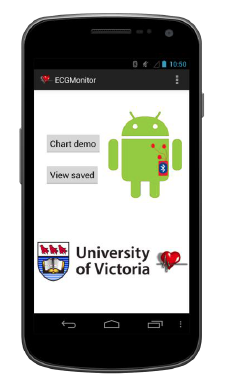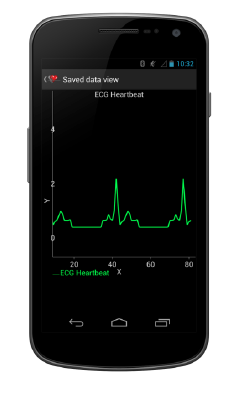Android Bluetooth Electrocardiogram is a
personalized home monitoring and feedback android app for ECG and heart
health. The main aim of this project is to build a low-cost
electrocardiogram device that can be easily used by someone with low
technical expertise. This project can be used as semester project or
final year project by Electronics/Communication Students.
You can download the complete source
code and project report of Android based Bluetooth Electrocardiogram
from the link below. The source code and project report are in a pdf
file which contains detailed description of the project: summary,
problem description, hardware overview, software overview, android
application overview, and future enhancements.
Android Bluetooth Electrocardiogram:
Electrocardiograms:
Electrocardiograms (ECGs) are
used by medical professionals to monitor the heart of a patient. These
devices usually operate with up to 12 leads connected to the patient’s
skin in a prescribed pattern. An ECG can be used to detect abnormal
cardiovascular symptoms, measure heart rates, and monitor heart
diseases.
The most common non-medical
application of an ECG is to measure a heart rate during a workout;
however, the aim of this project is to prototype a device that could aid
remote monitoring as well as feedback.
In addition to hospital based
systems, there are also long-term home monitoring systems such as
Holter monitors. These systems record 3 to 12 electrodes worth of data
onto the device, and are then brought in by the patient for analysis.
These monitors are intended to be used over longer periods or to test
for off-site conditions such as daily routine or specific triggers.
Why Android Platform:
The Android environment was
chosen for ECG software for multiple reasons. One reason for choosing
the Android platform is that it provides the option to run the app as a
‘service’, which allows it to run constantly in the background while iOS
does not provide this option to developers. And, Android application is
Java-based, which is a familiar language amongst the team members.
How the System Works:
The Android Bluetooth
Electrocardiogram consists of the software and hardware material for a
typical wireless electrocardiogram device. It also consists of Android
application which together with the hardware records and displays the
user’s heart signal and health.
The proposed prototype was developed to work in the following sequence:
- read the voltage signal generated by the test subject
- filter out the background noise, amplify the signal to a manageable level
- convert this analog signal to 10 digital bits
- transmit this signal over Bluetooth
- display the data graphically on the paired Android device
- save the data for future reference within the application
Future Possibilities:
Future enhancements and
further development of this prototype include: extending the android
application, firmware improvements, and hardware improvements. Extending
the Android application includes real-time heart rate monitoring and
analysis, multiple mobile devices attached to one ECG, and improved data
saving and analysis.
Firmware improvements include
migration to micro controller and low-power Bluetooth. Whereas,
hardware improvements include enhancements to the hardware components
such as leads, PCB, electrodes, isolation, and power.
Prototype Overview:


Conclusion:
The proposed prototype of a
personalized self-monitoring heart health android app can be used as a
reference project by Electronics/Communication students. It can also be
valuable as a starting point for those looking to create either a
similar project or extend the proposed prototype to meet the goals
detailed above.